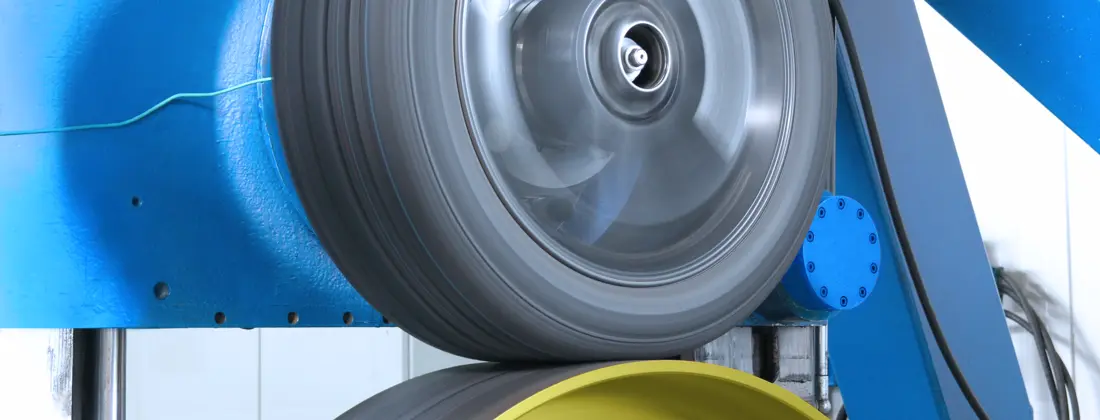GB T4512 Tyre Bead Unseating Strength Test
The GB T4512 tyre bead unseating strength test is a critical procedure designed to ensure the safety and performance of tyres, especially in high-stress environments such as those encountered by automotive vehicles. This test evaluates the resistance of the tyre bead area against forces that might cause it to separate from the rim. The tyre bead plays a crucial role in maintaining proper tyre inflation pressure and ensuring secure attachment to the rim.
The procedure outlined in GB T4512 is essential for quality control, especially during product development stages, as it helps manufacturers identify any potential weaknesses that could lead to bead separation under real-world conditions. This test ensures that tyres meet stringent safety standards, thereby contributing significantly to road safety.
The test setup involves mounting a sample tyre on a specially designed test rig. A force is then applied axially to the bead area until it disengages from the rim. The maximum force required for this separation is recorded as the unseating strength of the tyre bead. This value provides valuable insights into the durability and reliability of the tyre, which are critical considerations in automotive applications.
The test apparatus typically includes a hydraulic press or load cell capable of applying precise axial loads up to several thousand Newtons. The rig is equipped with sensors that can measure both force and displacement accurately. These measurements are crucial for obtaining reliable results that comply with GB T4512 specifications.
The process begins by selecting a representative sample of tyres that meet the relevant standards, such as ISO or ASTM, if applicable. The tyre is then mounted on the test rig according to specific guidelines provided in the standard. Careful attention must be paid to ensure accurate alignment and proper clamping of the tyre bead to prevent any external factors from influencing the results.
Once the setup is complete, the axial force is gradually increased until the tyre bead separates from the rim. The exact point at which this occurs determines the unseating strength. This value is typically expressed in Newtons (N). A higher unseating strength indicates better resistance to separation forces, which translates into enhanced safety and performance.
The test results are meticulously recorded and analyzed for compliance with GB T4512 requirements. Compliance with these standards ensures that the tyre meets the necessary safety and performance criteria set by regulatory bodies. This information is invaluable for quality managers, procurement officers, and R&D engineers who rely on test data to make informed decisions about product development and manufacturing processes.
The importance of this test cannot be overstated, as it directly impacts road safety and tyre durability. By adhering to GB T4512 specifications, manufacturers can produce tyres that are more reliable and safer for automotive applications.
Why It Matters
The GB T4512 tyre bead unseating strength test is vital for ensuring the safety and performance of tyres in high-stress environments. The tyre bead, which connects the tyre to the rim, must be able to withstand significant forces without separating. This separation can lead to dangerous situations on roads, including blowouts or loss of control.
Compliance with GB T4512 is essential for manufacturers aiming to meet strict safety standards set by regulatory bodies. These standards are designed to protect consumers and enhance overall road safety. By conducting this test, manufacturers can identify any weaknesses in the tyre bead design early in the development process, allowing for timely improvements.
The test results provide valuable insights into the durability and reliability of tyres, which are critical considerations for automotive applications. Quality managers and R&D engineers rely on these data to make informed decisions about product development and manufacturing processes. The information gathered from this test helps ensure that tyres perform consistently under various conditions, contributing to safer driving experiences.
Furthermore, consistent adherence to GB T4512 standards ensures that tyres are manufactured to the highest quality levels, enhancing consumer trust and satisfaction. This, in turn, can lead to increased market share for manufacturers who prioritize safety and performance.
Applied Standards
| Standard | Description |
|---|---|
| GB T4512 | This standard specifies the procedure for determining the unseating strength of tyre beads. It includes details on test equipment, specimen preparation, and data interpretation. |
| ISO 9001:2015 | An international standard that outlines the requirements for quality management systems. This ensures that the testing process is conducted in a controlled environment to maintain accuracy and reliability. |
| ASTM E476-18 | American Society for Testing Materials standard that provides guidelines for conducting tensile tests on rubber products, which includes tyre materials. It helps ensure consistency in test procedures across different laboratories. |
| EN 12653:2019 | This European norm specifies the method of determining the load-deflection characteristics of tyres. While not directly related to bead unseating strength, it complements other tests that contribute to overall tyre performance. |
Environmental and Sustainability Contributions
- The GB T4512 test ensures that tyres are robust enough to withstand the rigors of real-world driving conditions, reducing the likelihood of accidents caused by tyre failures.
- By identifying potential weaknesses early in the development process, manufacturers can improve tyre design and reduce waste associated with substandard products. This contributes to more sustainable manufacturing practices.
- The test promotes safer transportation, which is crucial for reducing carbon emissions from vehicles involved in accidents or breakdowns.
- Improved tyre durability means fewer replacements, leading to reduced resource consumption and lower environmental impact.
- Consistent compliance with GB T4512 ensures that tyres are produced at the highest quality levels, contributing to a more efficient use of natural resources.





